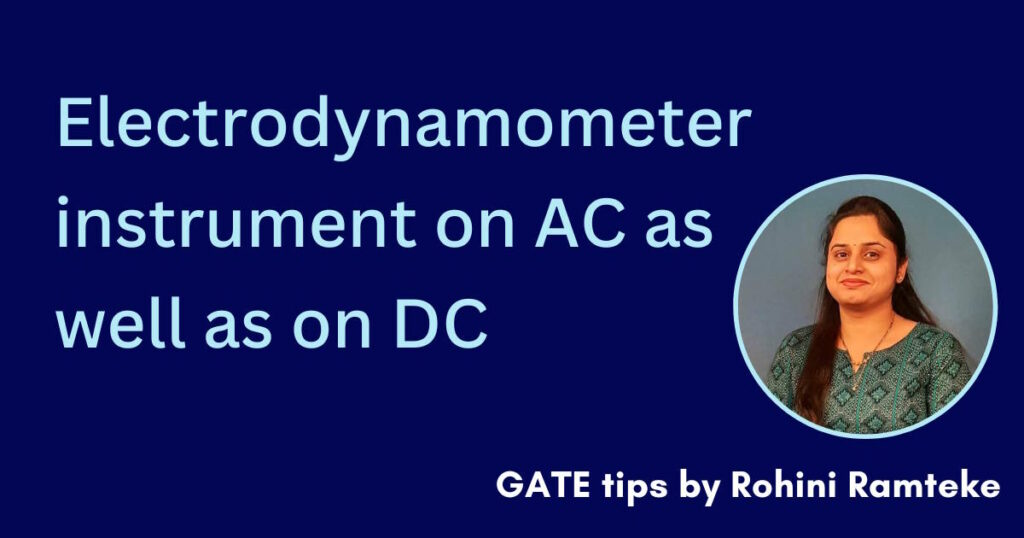Have you ever wondered how these versatile instruments measure current in a variety of electrical systems?
Whether you’re an electrical engineering enthusiast, a student, or simply curious about the inner workings of electrical measurement devices, this video is sure to leave you informed and inspired.
Don’t miss out on this captivating exploration of electrodynamometer-type instruments!
Hit that play button now or the link below and embark on a journey to uncover the secrets of their operation on both DC and AC circuits.
What is Electrodynamometer?
Let us first understand, that what actually means by electrodynamometer.
An electrodynamometer instrument is a type of electrical measuring instrument used for the measurement of electrical quantities such as current, voltage, power, and energy. It is based on the principle of electromagnetic forces generated between fixed and moving coils.
In general, Electrodynamometer is a modified version of the permanent magnet-moving coil instrument (PMMC). The magnet which is used in the PMMC instrument is permanent in nature. While the magnets which we use in electrodynamometer is made up of electro-magnets.
Electrodynamometer instruments are widely used in laboratories, industrial settings, and power systems for various electrical measurements.
They offer high accuracy, wide measurement range, and can handle both AC and DC measurements. They are particularly suitable for measuring power and energy because they can measure both active and reactive power components.
Construction of Electrodynamometer
Electrodynamometer consists of two coils fixed coil and moving coil. You can refer the diagram below.

The diagram above shown is the electrodynamometer.
The fixed coil is divided into two equal halves. The moving coil is placed in between the two fixed coil. The moving coil is also called as pressure coil.
The moving coil is connected in parallel with the load. The fixed coil is also called as current coil. As it is carries the current which is required by the load.
The moving coil has some potential differences across it, therefore a small amount of current also flows through the moving coil. T
Although both the coils carries current but the fixed coil contains large amount of current and the moving coil carries small amount of current with it.
Why the electrodynamometer is used in ac as well as on DC ?
Let us understand that how this electrodynamometer works on both ac as well as on dc
We will understand this with the help of two conditions.
1. When dc supply in given :- As we can see from the diagram, that the pressure coil or moving coil is attached to the spindle, and on the same spindle the pointer is attached. When the coil moves, it will show some reading.
Now, when we give dc supply , the current and voltage both flows in the coils. These are nothing but electromagnets.
When we give supply to this coil, the electromagnets get magnetized. Also, when we give dc supply these electromagnets form poles. i.e. North pole and South pole.
As we know that two poles are formed on two fixed coil, coil 1 is named as N pole and fixed coil 2 is named as S pole. Due to both of these electromagnets, magnetic field lines is generated between these two poles. Similarly, as a moving coil also carries current with it, so it will also create its own magnetic field lines.
Due to the interaction between these two fields the torque will be developed. Due to this torque, the pointer will start rotating.
By applying Fleming’s left-hand rule, we can find the direction of torque which is applied on the moving coil, and depending on that we can find the reading of the meter.
2. When ac supply is given :- In ac supply, there will be two half. i.e. positive half cycle and negative half cycle.
When we are given positive half cycle , terminal one is more positive as compared to terminal 2, fixed coil 1 is considered as N pole and fixed coil 2 is named as S pole. Due to these two poles, the magnetic field lines is created between the two poles.
Due to this , the moving coil starts rotating and the pointer will show some reading. This case of the positive half cycle is the same as that of the dc case.
Now, In the negative half cycle, the second terminal will become more negative as compared to the first terminal. Here the polarity gets reversed. As polarity gets reversed, the direction of current also changes. Therefore, the poles also change,
The fixed coil 1 is named as S pole and the fixed coil 2 is named as N pole, the direction of current is opposite to that of the positive half cycle.
The current will flow from North to the South direction, so magnetic field lines will also flow from the north to the south direction.
As both the arms shows opposite direction, the torque will be produced. The coil will start rotating and the meter will show some reading on the scale.
When we give positive as well as negative half cycle in both the cases, the pointer will rotate and the meter will show some reading.
Summarizing it all we see that, The electrodynamometer works on DC as well on AC, because in both cases, the moving coil is rotating and the meter is showing some readings.
So, when we compare the electrodynamometer with the PMMC instrument we see that,
| Electrodynamometer | PMMC Instrument |
| Works on both ac as well as on dc. | Works only on dc supply. |
| The magnets used here are electro magnets. | The magnet which we use here are permanent in nature. |
Hope, this article has made the reason cleared to you, that why the Electrodynamometer instrument is used in AC as well as on DC.
Do not forget to check our Awesome GATE courses.


